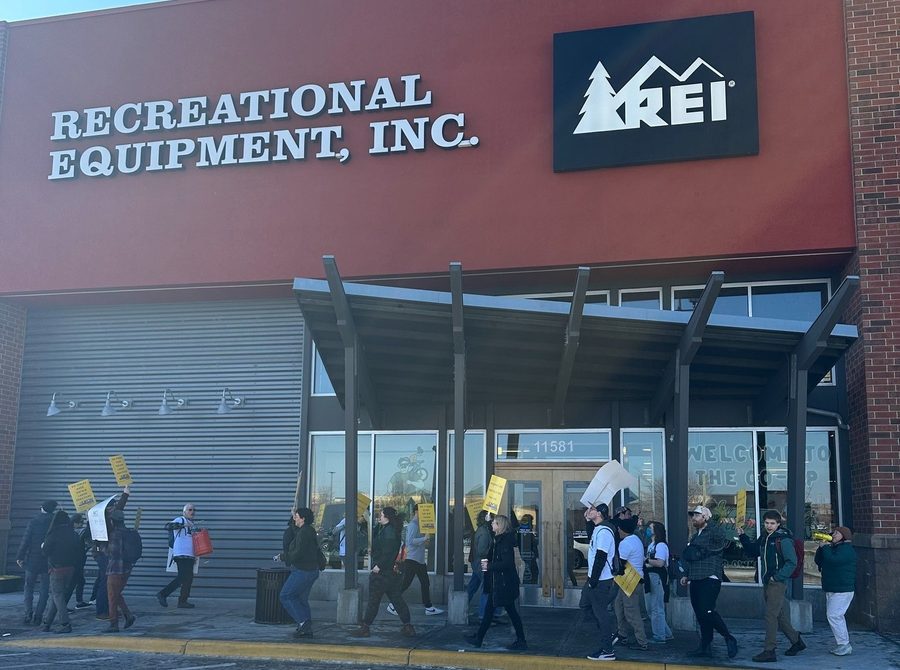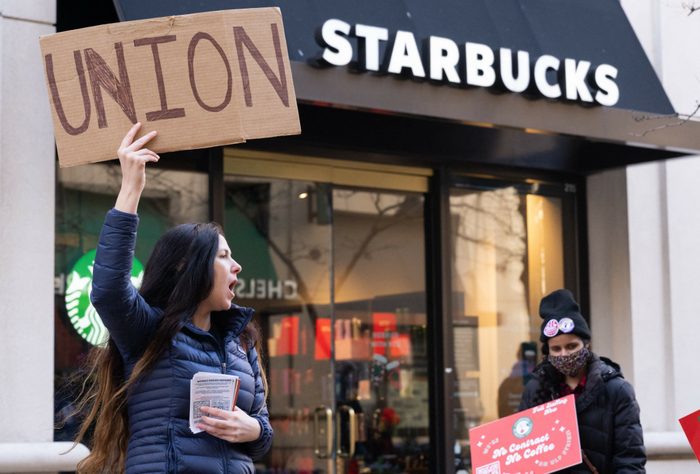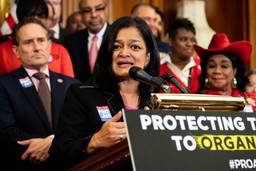Two Years In, These “Progressive” Companies Still Haven’t Negotiated First Union Contracts
The union wave at big U.S. retailers hasn’t yet resulted in first contracts for workers at Trader Joe’s, Starbucks and REI. But unions are proving their value in other ways.
Jeremy Gantz

Claire Chang and Steve Buckley knew it wasn’t going to be easy. But the two retail workers-turned-union organizers had been heartened by progress made during the first year of contract negotiations with REI, the outdoor gear and apparel chain. By June 2023 — more than a year after Chang and Buckley’s store in Manhattan became the first REI location in the country to unionize — the bargaining committee on which they serve had reached a number of tentative agreements with the company. “It seemed like we were building up a rhythm,” says Chang, who has worked at the REI store in SoHo for more than six years.
Then, negotiations quickly went south, Buckley says. REI began working with Morgan Lewis, a management-side law firm known in union circles for hardline, union-busting tactics. The company sent its lawyers to bargaining sessions alone, without any corporate managers, which Buckley saw as part of a new strategy to stretch out negotiations and sap the union’s strength. As of April, there’s been no progress toward a first contract for nearly a year. “Blatant disregard and openly hostile negotiations aren’t productive,” Buckley says. The company has “continued to get worse and worse because they’re embracing their worst impulses.”
Talk to union members at Trader Joe’s, which (like REI and Starbucks) also has unionized retail stores across the country pushing for a first contract, and you’ll hear similar things. Four Trader Joe’s stores have unionized since July 2022 (and another has filed for union election), 9 REI stores have unionized since March 2022 (with another store election coming later this month) and nearly 400 Starbucks stores have unionized since December 2021. The efforts at these companies, which have all tried to burnish progressive reputations, provide a window into the challenging process of negotiating a first contract more than two years after a wave of unionizing first hit the retail industry.
Trader Joe’s Union (TJU) Vice President Sarah Beth Ryther describes contract negotiations this way: “Every single bargaining session is excruciatingly long. Eight hours where almost nothing happens.” The company’s strategy, she says, is: “We will waste all of your resources as much as possible, we will dangle tiny little treats that won’t come to fruition.”
Ryther and Chang are heartened by the recent news that Starbucks and its union, Workers United, would resume in-person bargaining in late April after a lengthy break. For the first time, the company has signaled support for a potential national labor accord, agreeing to meet with workers from union stores across the country. But the apparent breakthrough at Starbucks has yet to alter the bargaining dynamic at Trader Joe’s and REI. Workers at all three retail companies learned a painful truth over the past two years: Just because a corporation cultivates a progressive veneer doesn’t mean it will welcome a union.
The recent Starbucks news is “promising,” Ryther says. “But we’ve seen these enormous corporations make many of the same promises before.”
John Logan, a professor of labor history at San Francisco State University, is not convinced Starbucks’ new union rhetoric will lead to a strong first contract anytime soon. The company has said it wants to complete bargaining and contract ratification this year.
“It’s hard to imagine the company agreeing to a contract that provides an incentive for workers in non-union stores to unionize,” Logan says. Still, workers and their union will continue pushing for better wages, benefits and working conditions when bargaining sessions finally restart.
Waiting workers out
In lieu of progress at the bargaining table, the three unions that have kept organizing momentum going after initial historic victories — Trader Joe’s United, Workers United and the Retail, Wholesale and Department Store Union (which REI workers joined) — have spent a lot of time in court.
The National Labor Relations Board (NLRB), the agency charged with enforcing federal labor law, has ruled in the unions’ favor dozens of times on various matters, including illegal retaliatory firings and finding that Starbucks has failed to bargain in good faith. The NLRB has ruled similarly against Amazon, which still refuses to recognize the validity of Amazon Labor Union’s (ALU) sole warehouse union victory in April 2022.
In fact, the NLRB has filed more than 125 complaints against Starbucks. Late in 2023, the Retail, Wholesale and Department Store Union filed 80 unfair labor practice charges against REI with the NLRB, alleging a “concerted, multi-pronged union-busting campaign” including retaliatory firings, schedule changes and disciplinary actions. TJU has filed similar charges against the grocery store chain. Starbucks, REI and Trader Joe’s have denied all wrongdoing, although they have settled specific charges. An REI spokesperson said in an email that the company “is committed to and engaged in good-faith bargaining.” Starbucks and Trader Joe’s did not respond to emailed questions.
It’s amazing how much — and yet how little — can happen in two years, when it comes to first contract negotiations. It has long been a slow process, and it appears to be lengthening. Economic Policy Institute research found that between 1999 and 2003, 37% of newly unionized workplaces didn’t have a first contract after two years, while 30% didn’t have one after three years. A study of union elections in 2018 found that 63% didn’t reach a first contract in the first year after organizing and 43% still didn’t reach one after two years. That study also concluded that employer obstruction through unfair labor practices served as a major impediment to negotiating a first contract.
Such lengthy delays would likely increase if the courts side with anti-union forces’ latest tactics. In January, Morgan Lewis introduced a new innovation to the corporate anti-union playbook. The firm, which (along with REI) represents Trader’s Joe’s, Amazon and SpaceX, began arguing before the NLRB that the 89-year-old agency’s structure is unconstitutional. The argument, which challenges long-standing legal precedents, claims that the NLRB “violates constitutional separation of powers and due process protections by wielding different types of authority in the same case,” Bloomberg Law reported. Starbucks began making a similar argument in February in a case that will head to the Supreme Court for oral argument later this month. If the court rules in favor of Starbucks, the NLRB’s ability to reinstate workers fired during a union campaign could be curtailed.
These companies are “so frustrated that they’re working to basically take down the National Labor Relations Act (NLRA) and the NLRB,” says Seth Goldstein, who represents both TJU and the Amazon Labor Union. “Because they can’t defeat us any other way. This is an attack on the American labor movement.”
During a contract bargaining session in February, Goldstein says he asked Trader Joe’s Deputy General Counsel Nancy Inesta whether she recognized the validity of the NLRA and the NLRB’s jurisdiction over the company’s practices. “She refused to agree to that,” Goldstein says. “It’s not normal to talk to someone like it’s 1920.” The NLRA, passed during the height of the New Deal in 1935, enshrined the idea of workers’ collective bargaining rights into federal law and created the NLRB.
Two years into the retail unionization wave, and even with the most pro-union NLRB in decades calling companies out for their illegal tactics, corporate intransigence in the sector appears as strong as ever (with the exception of Starbucks). Through their efforts to delay bargaining, including retaliation and litigation, companies are trying to turn time and employee turnover into an ally, hoping that worker morale drops, solidarity erodes and union decertification efforts multiply.
In the face of opposition, how are unions proving their value to members and staying strong as the contract fight drags on?
Bringing embattled unions to life
Barista Parker Davis has one answer to that question: protect and defend the day-to-day and month-to-month needs of members whenever necessary.
In November 2022, just a few months after Davis’ San Antonio Starbucks store unionized, the building’s drains backed up, forcing a three-day closure. While the drainage problem was being fixed, management reduced shift lengths and sent many workers home. The union then asked for workers to be paid for their scheduled shifts, citing a “catastrophic pay” policy in the company’s employee guide that stipulates employees will be paid if a store is closed due to a natural disaster.
“We knew that other stores had gotten catastrophic pay when their power had been cut temporarily,” says Davis, who played a lead role in unioning his store two years ago. Similarly, “our water services weren’t working, essentially.”
But the company refused to pay the workers and, in response, the union demanded to bargain over the impacts of the store closure decision. Starbucks flew lawyers from union avoidance firm Littler Mendelson into San Antonio for a five-hour bargaining session. It was contentious, but the company ended up agreeing to compensate baristas for their scheduled shifts.
“It was such a small amount of money compared to the company’s overall profits,” Davis says. “It seemed like an odd thing to fight over. But it definitely strengthened [the union at] my store.”
That’s just one tangible win achieved without a contract at a unionized Starbucks store. Davis and his colleagues have banded together to defend their interests in other ways as well, such as pushing back against a manager’s plan to reorganize storage in the front and back-of-house. The union made clear such changes to working conditions would need to be negotiated with the bargaining unit, Davis says.
The ability to have a say in how supplies are stored is not the primary reason that around 400 Starbucks stores have unionized. But it’s an example of how the union is a tangible and valuable presence, even without a contract in hand. “At the end of the day, a union is workers coming together to care for each other,” Davis says.

TJU’s Ryther says that after it became clear Trader Joe’s was slow-walking contract negotiations, her union began framing conversations with workers differently. “A contract is the ultimate goal, but we’re focusing more on small wins, empowering folks, unfair labor practices and training media ambassadors,” says Ryther, a Trader Joe’s crew member in Minneapolis.
Without a contract in place, TJU can’t collect dues from members to fund its operations. But that hasn’t stopped the union from building a “kind of advocacy network” for unionized grocery stores. Each store has a Discord channel on which workers can post about problems with managers and disciplinary actions, learn about their rights as a union member, or just chat about shift swaps, Ryther says. (One example of a right that TJU members have taken advantage of: under federal labor law, union members can request union representation whenever an employer’s investigatory interview could lead to discipline.)
“A bunch of people will say, ‘Here are your rights. This is legal or illegal. Here’s what it says in the Trader Joe’s handbook,’” Ryther says.
This is how a culture of unionism is being built at Trader Joe’s — member to member, one Discord chat or in-person conversation at a time. Ryther doesn’t see high store turnover rates as a big impediment to sustaining the union’s strength. “Sometimes folks’ lack of knowledge of unions plays to our favor,” she says. “Some people don’t even know what a contract is. But they start working at a store and say, ‘This is great.’ People underestimate the power of an established store culture.”
Sustaining and growing the union in the face of steadfast corporate opposition starts with conversations that build relationships and trust. “You have to meet people where they’re at,” Ryther says. In-store organizing and member engagement is not transactional and it’s not about persuasion: “90% of the time, you should be talking about weather, sports, holiday plans, family traditions — it’s social skills 101.”
Buckley and Chang at REI echo the importance of whole-member organizing as contract fights continue. “We see our co-workers as whole people, not just who they are at work,” Buckley says. “We show up in each other’s lives. We’re building a community so that when the hard times come, we have each other’s backs.”
Having each others’ back can mean covering a shift that a coworker can no longer work, or connecting someone with a union lawyer to file an unfair labor practice complaint with the NLRB. But it’s also about helping a coworker get through a tough financial spot. Workers at the REI SoHo store created a REI Union Hardship Fund to support each other. In San Antonio, Starbucks union members have set up mutual aid systems, Parker says.
“Sometimes, it’s as simple as someone needing $20 for gas money,” he says. “Of course we’re going to offer that to them. It’s about always being there for someone.”
Marathon fights continue
Union workers at Starbucks, REI and Trader Joe’s know they’re running a marathon. Any initial optimism that contracts could be negotiated (relatively) quickly is now gone. In its place? A steely determination that comes from knowing exactly who they’re up against. And in workers who have now spent years pushing for change, an awareness of how leaning on each other can help prevent burnout.
“It’s a real issue,” Ryther says. “Most of us are working full-time jobs, right? This is an incredible amount of work. It gets easier in terms of knowledge over time, but it doesn’t get easier in terms of having to build new relationships constantly.”
When you consider what the retail unions are up against — high employee turnover rates, an array of illegal union-busting tactics and now an apparent effort to dismantle the legal infrastructure that has governed businesses and labor in this country for generations — their willingness to go on offense becomes more improbable. Unionized workers have staged walkouts and a string of short, targeted strikes, including thousands of Starbucks workers at more than 200 stores in November 2023.
In March, REI workers from across the country showed up uninvited at the company’s corporate office in Issaquah, Washington. They protested outside carrying signs bearing messages such as “Ask me about my raise (REI took it away).”
In the REI, Starbucks and Trader Joe’s campaigns, unions are calling attention to the gaps between the companies’ supposed progressive values and the way workers are being treated when they organize collectively. That’s particularly true of REI, which is structured as a member-owned cooperative, and whose leadership views climate change as an existential threat and has committed to becoming an “anti-racist” organization. There’s “tremendous opportunity for customers to be engaged and push for changes inside the co-op to be the kind of place they know it should be and they assume that it is,” Buckley says.
That kind of public pressure has yet to be seen. Still, Starbucks’ new stance may be partly an attempt to repair damage to its reputation, Logan says, as well as the result of unofficial boycotts over union-busting efforts and the appearance of a new, more pragmatic CEO. (Starbucks in February said it now wants to resolve outstanding litigation and come to agreement with Workers United on a “fair process for organizing.”)
“It’s not entirely clear why Starbucks decided to reverse course — assuming this is what has happened,” Logan says. A realization that the union wasn’t going away may have also been a factor, he adds.
It may not be a coincidence that, compared with REI and Trader Joe’s, Starbucks now has many more unionized stores. Store-based organizing may be the strongest argument to corporate executives that workers’ demands won’t dissipate any time soon. For these campaigns to succeed, they’ve “got to be based on empowering workers to organize their own stores,” Logan says. “That’s what young people want to do, and that’s the only way you can win against these companies.”
The fights continue. In February, baristas at 21 Starbucks stores informed the company they intended to organize. In mid-March, REI workers in Santa Cruz, Calif. announced their intention to unionize; they’ll vote later this month. And on April 8, Trader Joe’s employees in Chicago followed suit.
“We’re responding to [the company’s] legal onslaught with our own, while also trying to organize new locations,” Buckley says. “Any time we’ve seen massive changes in union density in this county, it’s when workers lead the campaigns and lead the shop floor.”
Jeremy Gantz is an In These Times contributing editor working at Time magazine.








